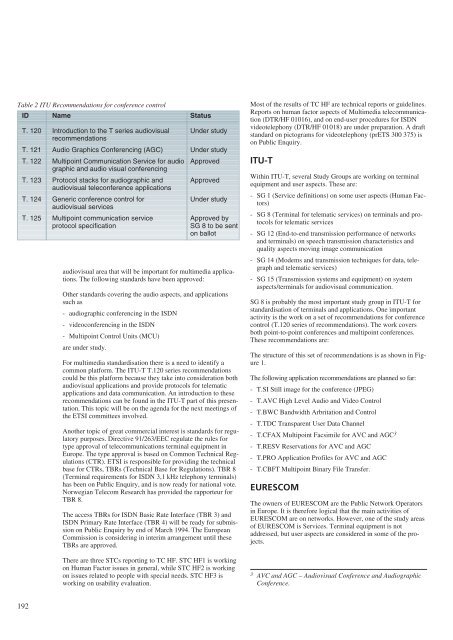Prognosemetoder – en oversikt - Telenor
Prognosemetoder – en oversikt - Telenor
Prognosemetoder – en oversikt - Telenor
You also want an ePaper? Increase the reach of your titles
YUMPU automatically turns print PDFs into web optimized ePapers that Google loves.
Table 2 ITU Recomm<strong>en</strong>dations for confer<strong>en</strong>ce control<br />
ID Name Status<br />
T. 120 Introduction to the T series audiovisual<br />
recomm<strong>en</strong>dations<br />
Under study<br />
T. 121 Audio Graphics Confer<strong>en</strong>cing (AGC) Under study<br />
T. 122 Multipoint Communication Service for audio<br />
graphic and audio visual confer<strong>en</strong>cing<br />
Approved<br />
T. 123 Protocol stacks for audiographic and<br />
audiovisual teleconfer<strong>en</strong>ce applications<br />
Approved<br />
T. 124 G<strong>en</strong>eric confer<strong>en</strong>ce control for<br />
audiovisual services<br />
Under study<br />
T. 125 Multipoint communication service Approved by<br />
protocol specification SG 8 to be s<strong>en</strong>t<br />
on ballot<br />
192<br />
audiovisual area that will be important for multimedia applications.<br />
The following standards have be<strong>en</strong> approved:<br />
Other standards covering the audio aspects, and applications<br />
such as<br />
- audiographic confer<strong>en</strong>cing in the ISDN<br />
- videoconfer<strong>en</strong>cing in the ISDN<br />
- Multipoint Control Units (MCU)<br />
are under study.<br />
For multimedia standardisation there is a need to id<strong>en</strong>tify a<br />
common platform. The ITU-T T.120 series recomm<strong>en</strong>dations<br />
could be this platform because they take into consideration both<br />
audiovisual applications and provide protocols for telematic<br />
applications and data communication. An introduction to these<br />
recomm<strong>en</strong>dations can be found in the ITU-T part of this pres<strong>en</strong>tation.<br />
This topic will be on the ag<strong>en</strong>da for the next meetings of<br />
the ETSI committees involved.<br />
Another topic of great commercial interest is standards for regulatory<br />
purposes. Directive 91/263/EEC regulate the rules for<br />
type approval of telecommunications terminal equipm<strong>en</strong>t in<br />
Europe. The type approval is based on Common Technical Regulations<br />
(CTR). ETSI is responsible for providing the technical<br />
base for CTRs, TBRs (Technical Base for Regulations). TBR 8<br />
(Terminal requirem<strong>en</strong>ts for ISDN 3,1 kHz telephony terminals)<br />
has be<strong>en</strong> on Public Enquiry, and is now ready for national vote.<br />
Norwegian Telecom Research has provided the rapporteur for<br />
TBR 8.<br />
The access TBRs for ISDN Basic Rate Interface (TBR 3) and<br />
ISDN Primary Rate Interface (TBR 4) will be ready for submission<br />
on Public Enquiry by <strong>en</strong>d of March 1994. The European<br />
Commission is considering in interim arrangem<strong>en</strong>t until these<br />
TBRs are approved.<br />
There are three STCs reporting to TC HF. STC HF1 is working<br />
on Human Factor issues in g<strong>en</strong>eral, while STC HF2 is working<br />
on issues related to people with special needs. STC HF3 is<br />
working on usability evaluation.<br />
Most of the results of TC HF are technical reports or guidelines.<br />
Reports on human factor aspects of Multimedia telecommunication<br />
(DTR/HF 01016), and on <strong>en</strong>d-user procedures for ISDN<br />
videotelephony (DTR/HF 01018) are under preparation. A draft<br />
standard on pictograms for videotelephony (prETS 300 375) is<br />
on Public Enquiry.<br />
ITU-T<br />
Within ITU-T, several Study Groups are working on terminal<br />
equipm<strong>en</strong>t and user aspects. These are:<br />
- SG 1 (Service definitions) on some user aspects (Human Factors)<br />
- SG 8 (Terminal for telematic services) on terminals and protocols<br />
for telematic services<br />
- SG 12 (End-to-<strong>en</strong>d transmission performance of networks<br />
and terminals) on speech transmission characteristics and<br />
quality aspects moving image communication<br />
- SG 14 (Modems and transmission techniques for data, telegraph<br />
and telematic services)<br />
- SG 15 (Transmission systems and equipm<strong>en</strong>t) on system<br />
aspects/terminals for audiovisual communication.<br />
SG 8 is probably the most important study group in ITU-T for<br />
standardisation of terminals and applications. One important<br />
activity is the work on a set of recomm<strong>en</strong>dations for confer<strong>en</strong>ce<br />
control (T.120 series of recomm<strong>en</strong>dations). The work covers<br />
both point-to-point confer<strong>en</strong>ces and multipoint confer<strong>en</strong>ces.<br />
These recomm<strong>en</strong>dations are:<br />
The structure of this set of recomm<strong>en</strong>dations is as shown in Figure<br />
1.<br />
The following application recomm<strong>en</strong>dations are planned so far:<br />
- T.SI Still image for the confer<strong>en</strong>ce (JPEG)<br />
- T.AVC High Level Audio and Video Control<br />
- T.BWC Bandwidth Arbritation and Control<br />
- T.TDC Transpar<strong>en</strong>t User Data Channel<br />
- T.CFAX Multipoint Facsimile for AVC and AGC3 - T.RESV Reservations for AVC and AGC<br />
- T.PRO Application Profiles for AVC and AGC<br />
- T.CBFT Multipoint Binary File Transfer.<br />
EURESCOM<br />
The owners of EURESCOM are the Public Network Operators<br />
in Europe. It is therefore logical that the main activities of<br />
EURESCOM are on networks. However, one of the study areas<br />
of EURESCOM is Services. Terminal equipm<strong>en</strong>t is not<br />
addressed, but user aspects are considered in some of the projects.<br />
3 AVC and AGC <strong>–</strong> Audiovisual Confer<strong>en</strong>ce and Audiographic<br />
Confer<strong>en</strong>ce.
















